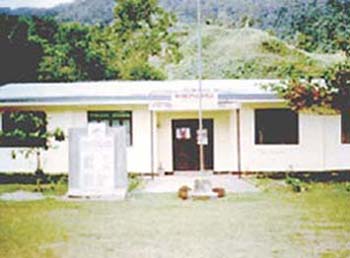

| Municipality of ADAMS |

The municipality of Adams is a young and underdeveloped town in the province of Ilocos Norte, The fact that it was a former municipal district of the town of Bangui. It was converted into a regular minicipality by virtue of Batas Pambansa Bilang 337, Sec. 16 of the Local Government Code. Its name was derived from the first inhabitants who settled at the bank of the Bolo River who were mostly cultural minorities. Since these natives were mostly naked, they were called "Adan" as they said that they were direct descendants of Adam and Eve. When the Americans landed in the settlement, they changed the name Adan into "Adams" and since then, it became the official name of the town. Adams is located in the northernmost tip of Ilocos Norte. It is bounded on the north and west by the municipality of Pagudpud, on the east by the province of Cagayan and Kalinga-Apayao, and the south by the municipality of Dumalneg. It is 112 kilometers away from the urban center, Laoag City and approximately 560 kilometers form Manila. Having only one barangay, it has an aggregate land area of 13,336 hectares. The physical feature of the land is hilly, mountainous and with plains covered with virgin forests. It has a long wet season and a short dry season since its climate is affected by the climate of Cagayan Valley and Mountain Province. Just like Baguio City, it is foggy during the cold months. The municipality of Adams is thinly populated. The people are hardworking, thrifty and somewhat clannish, the fact that they are cultural minorities. With only a few Christian families in the area, the townspeople still maintained their old culture, customs and traditions. Most of them still wear their ancient costumes, the "baag" (g-string) for the males and "tapis" (long-skirt) for the females. The primary source of livelihood for the people is farming and fishing. The major crops are rice, root crops, fruits (bananas, avocados, pineapple) and vegetable like cabbage, pechay, and others. Some of the people are engaged in home industries like rattan and furniture-making. Due to the hilly terrain, the road going to Adams is unpassable during the rainy season and the only available means of transportation is by horseride or by motercycles. During the summer months, however, jeeps and buses can be used as means of transportation. It has a complete elementary school, a health center, a town plaza and a public auditorium. It has also a basketball court for sports development. There are no big commercial establishments excepts for small sari-sari stores around the town. As a traveller climbs the mountains going to this municipality, one can see tall pine trees thriving on the mountain slopes, wild plants and animals. There are several varieties of orchids and ornamental plants which anybody could take as a gift from the natives. The site of the rice terraces stretching on the slopes of the hills and a hanging bridge across the river are but a few of the fascinating sites the town offers. During its town fiesta, the colorful costumes and dances of the Igorots, Itnegs and Apayaos are shown. It is here where a tourist can observe the culture without necessarily going up to Baguio |





